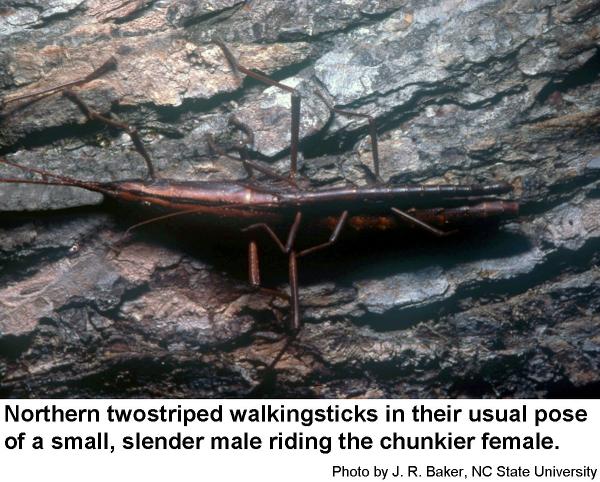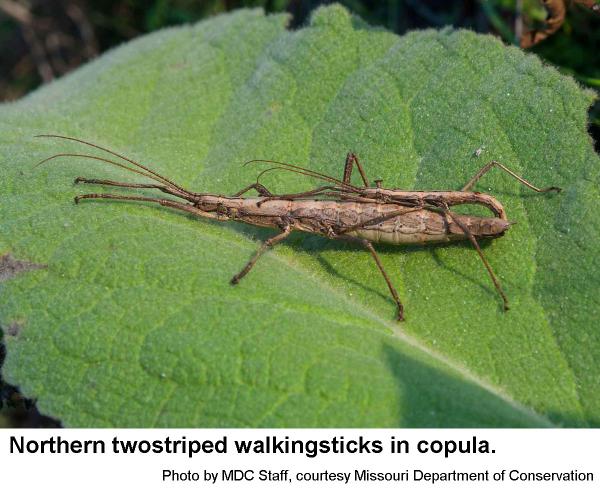Description and Biology
The northern twostriped walking stick, Anisomorpha ferruginea, is a somewhat chunky walkingstick insect that matures and lays its eggs in the fall. Females are brown and about 4 inches long. Males are skinnier and smaller (11/2 inches long). These walkingsticks have been called devil's riding horses, prairie alligators, stick bugs, witch's horses, devil's darning needles, scorpions, and especially in the case of the northern two-striped walkingstick, musk mares and spitting devils. These walkingsticks feed on various trees and shrubs including landscape shrubs. This species often occurs in copula, with the relatively small, slender male riding on the back of a larger, stouter female. The eggs are laid in a dense mass on bark and other objects. One unpleasant feature of this species is its ability to squirt out a irritating defensive secretion when they are disturbed. Do not examine them closely as the secretion is very irritating to the eyes. They can squirt their irritating fluid up to a foot. Although northern twostriped walkingsticks are not common in North Carolina, when they do occur they can be numerous and damaging. A second, even less common large walkingstick here in North Carolina is the twostriped walkingstick, Anisomorpha buprestoides. It has somewhat to much more distinct parallel stripes along the back.
Host Plants
Anisomorpha walkingsticks have been reported feeding on trees and shrubs including azalea, crapemyrtle, lyonia or staggerbush, oak, privet, and roses.
Residential Recommendations
In late fall (when adults are most abundant and conspicuous), Anisomorpha walking sticks are fairly difficult to control because the cool weather slows the activity of pesticides down and the insects are apparently capable of metabolizing the pesticides before they perish. It is a good idea to use a tablespoon of liquid hand dish-washing detergent in each gallon of spray along with a contact insecticide such as Orthene or a pyrethroid to increase the penetration of the pesticide through the integument. When used as directed, pyrethroids are very toxic to insects but are not particularly hazardous to humans and pets (other than fish-avoid using pyrethroids around pools, ponds, and streams). Most ornamentals are sufficiently hardened off in the fall so that the soap will not damage the foliage. Spraying should be done in the warmest part of the day, preferably on a warm fall day.
References
- Anisomorpha ferruginea, Northern Two-striped Walkingstick. Anonymous. No Date. EOL, Encyclopedia of Life.
- Common name: twostriped walkingstick, scientific name: Anisomorpha buprestoides (Stoll) (Insecta: Phasmatodea: Pseudophasmatidae). Thomas, M. C. 2014 (reviewed). Featured Creatures, Entomology & Nematology, FDACS/DPI, EDIS. Publication Number: EENY-314.
- Northern Two-Striped Walkingstick (Musk Mare), Anisomorpha ferruginea. Anonymous, No Date. Missouri Department of Conservation.
- NC State Extension Plant Pathology Publications
- NC State Horticultural Science Publications
- North Carolina Agricultural Chemicals Manual
For assistance with a specific problem, contact your local Cooperative Extension center.
This factsheet has not been peer reviewed.
Publication date: Aug. 29, 2017
Reviewed/Revised: Oct. 7, 2019
Recommendations for the use of agricultural chemicals are included in this publication as a convenience to the reader. The use of brand names and any mention or listing of commercial products or services in this publication does not imply endorsement by NC State University or N.C. A&T State University nor discrimination against similar products or services not mentioned. Individuals who use agricultural chemicals are responsible for ensuring that the intended use complies with current regulations and conforms to the product label. Be sure to obtain current information about usage regulations and examine a current product label before applying any chemical. For assistance, contact your local N.C. Cooperative Extension county center.
N.C. Cooperative Extension prohibits discrimination and harassment regardless of age, color, disability, family and marital status, gender identity, national origin, political beliefs, race, religion, sex (including pregnancy), sexual orientation and veteran status.


